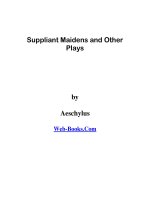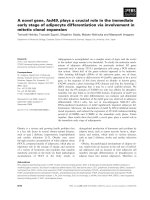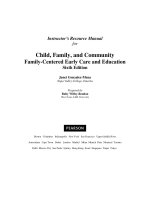Early Plays
Bạn đang xem bản rút gọn của tài liệu. Xem và tải ngay bản đầy đủ của tài liệu tại đây (84.91 KB, 11 trang )
Early Plays
by
Henrik Ibsen
Web-Books.Com
Early Plays
Introduction......................................................................................................................... 3
Catiline: Preface.................................................................................................................. 7
Catiline: Dramatis Personae.............................................................................................. 12
Catiline.............................................................................................................................. 13
First Act ........................................................................................................................ 13
Second Act.................................................................................................................... 36
Third Act....................................................................................................................... 66
The Warrior's Barrow ....................................................................................................... 96
Olaf Liljekrans ................................................................................................................ 126
Dramatis Personae ...................................................................................................... 126
First Act ...................................................................................................................... 127
Second Act.................................................................................................................. 167
Third Act..................................................................................................................... 202
Introduction
One of the most remarkable facts about Ibsen is the orderly development of his
genius. He himself repeatedly maintained that his dramas were not mere
isolated accidents. In the foreword to the readers in the popular edition of 1898
he urges the public to read his dramas in the same order in which he had written
them, deplores the fact that his earlier works are less known and less understood
than his later works, and insists that his writings taken as a whole constitute an
organic unity. The three of his plays offered here for the first time in English
translation will afford those not familiar with the original Norwegian some light on
the early stages of his development.
Catiline, the earliest of Ibsen's plays, was written in 1849, while Ibsen was an
apothecary's apprentice in Grimstad. It appeared in Christiania in the following
spring under the pseudonym Brynjolf Bjarme. The revolutionary atmosphere of
1848-49, the reading of the story of Catiline in Sallust and Cicero in preparation
for the university examinations, the hostility which existed between the
apprentice and his immediate social environment, the fate which the play met at
the hands of the theatrical management and the publishers, his own struggles at
the time,--are all set forth clearly enough in the preface to the second edition.
The play was written in the blank verse of Oehlenschlaeger's romantic dramas.
Ibsen's portrayal of the Roman politician is not in accord with tradition; Catiline is
not an out-and-out reprobate, but an unfortunate and highly sensitive individual in
whom idealism and licentiousness struggle for mastery. Vasenius, in his study of
the poet (Ibsens Dramatiska Diktning in dess Första Skede, Helsingfors, 1879),
insists that Ibsen thus intuitively hit upon the real Catiline revealed by later
nineteenth century research. The poet seems not to have heard of Duma's
Catiline, which appeared about the same time, nor of earlier plays on the subject
by Ben Jonson and others. The struggle in Ibsen's play is centered in the soul of
Catiline; not once do his political opponents appear on the scene. Only one critic
raised his voice in behalf of the play at the time of its appearance, and only a few
copies of the original edition survive. Ibsen issued in 1875 a revised edition in
celebration of his twenty-fifth anniversary as an author. Since then a third edition
has been issued in 1891, and a fourth in 1913.
The Warrior's Barrow, Ibsen's second play, was finished in 1850 shortly after the
publication of Catiline. Ibsen entered upon his literary career with a gusto he
seems soon to have lost; he wrote to his friend Ole Schulerud in January, 1850,
that he was working on a play about Olaf Trygvesson, an historical novel, and a
longer poem. He had begun The Warrior's Barrow while he was still at Grimstad,
but this early version, called The Normans, he revised on reaching Christiania.
In style and manner and even in subject-matter the play echoes
Oehlenschlaeger. Ibsen's vikings are, however, of a fiercer type than
Oehlenschlaeger's, and this treatment of viking character was one of the things
the critics, bred to Oehlenschlaeger's romantic conception of more civilized
vikings, found fault with in Ibsen's play. The sketch fared better than Catiline: it
was thrice presented on the stage in Christiania and was on the whole favorably
reviewed. When Ibsen became associated with the Bergen theater he undertook
another revision of the play, and in this version the play was presented on the
stage in 1854 and 1856. The final version was published in the Bergenske Blad
in 1854, but no copy of this issue has survived; the play remained inaccessible to
the public until 1902, when it was included in a supplementary volume (Volume
X) to Ibsen's collected works. The earlier version remained in manuscript form
until it was printed in 1917 in Scandinavian Studies and Notes (Vol. IV, pp. 309-
337).
Olaf Liljekrans, which was presented on the Bergen stage in 1857, marks the end
of Ibsen's early romantic interest. The original idea for this play, which he had
begun in 1850, he found in the folk-tale "The Grouse in Justedal," about a girl
who alone had survived the Black Death in an isolated village. Ibsen had with
many others become interested in popular folk-tales and ballads. It was from
Faye's Norwegian Folk-Tales (1844) that he took the story of "The Grouse in
Justedal." His interest was so great that he even turned collector. Twice during
this period he petitioned for and received small university grants to enable him to
travel and "collect songs and legends still current among the people." Of the
seventy or eighty "hitherto unpublished legends" which he collected on the first of
these trips only a few have ever appeared in print; the results of his second trip
are unknown. Ibsen had great faith in the availability of this medieval material for
dramatic purposes; he even wrote an essay, "The Heroic Ballad and Its
Significance for Artistic Poetry," urging its superior claims in contrast to that of the
saga material, to which he was himself shortly to turn. The original play based on
"The Grouse in Justedal" was left unfinished. After the completion of Lady Inger
of Östråt and The Feast at Solhoug he came back to it, and taking a suggestion
from the ballad in Landstad's collection (1852-3) he recast the whole play,
substituted the ballad meter for the iambic pentameters, and called the new
version Olaf Liljekrans. Olaf Liljekrans indicates clearly a decline in Ibsen's
interest in pure romance. It is much more satirical than The Feast at Solhoug,
and marks a step in the direction of those superb masterpieces of satire and
romance, Brand and Peer Gynt. The play was twice presented on the stage in
Bergen with considerable success, but the critics treated it harshly.
The relationship of the revised versions to the original versions of Ibsen's early
plays is interesting, and might, if satisfactorily elucidated, throw considerable light
on the development of his genius. It is evident that he was in this early period
experimenting in metrical forms. He employed blank verse in Catiline, in the
original version of The Grouse in Justedal, and even as late as 1853 in the
revision of The Warrior's Barrow. There can be no question but that he was here
following the Ochlenschlaeger tradition. Unrhymed pentameter, however, did not
seem to satisfy him. He could with difficulty keep from falling into rhyme in
Catiline, and in the early version of The Warrior's Barrow he used rhymed
pentameters. After the revision of this play he threw aside blank verse
altogether. "Iambic pentameter," he says in the essay on the heroic ballad, "is by
no means the most suitable form for the treatment of ancient Scandinavian
material; this form of verse is altogether foreign to our national meters, and it is
surely through a national form that the national material can find its fullest
expression." The folk-tale and the ballad gave him the suggestion he needed. In
The Feast at Solhoug and the final version of Olaf Liljekrans he employed the
ballad meter, and this form became the basis for the verse in all his later metrical
plays.
Six years intervened between The Grouse in Justedal and Olaf Liljekrans, and
the revision in this case amounted almost to the writing of a new play. Fredrik
Paasche in his study (Olaf Liljekrans, Christiania, 1909) discusses the relation of
Olaf Liljekrans to the earlier form of the play. Three years intervened between
the first and final versions of The Warrior's Barrow. Professor A. M. Sturtevant
maintains (Journal of English and Germanic Philology, XII, 407 ff.) that although
"the influence of Ochlenschlaeger upon both versions of The Warrior's Barrow is
unmistakable," yet "the two versions differ so widely from each other ... that it
may be assumed that ... Ibsen had begun to free himself from the thraldom of
Ochlenschlaeger's romantic conception of the viking character." He points out
the influence of Welhaven and Heiberg on the second version, elaborates upon
the superior character-delineation, and shows in considerable detail the "inner
necessity ... which brings about the change of heart in Gandalf and his warriors."
The revision of Catiline came twenty-five years after the original version, and
consisted largely of linguistic changes. Ibsen seems never to have completely
disowned this play; it has been included in all the complete editions, whereas
The Warrior's Barrow and Olaf Liljekrans appear only in the first complete edition,
and were even then relegated to a supplementary volume. In suggesting the
revision of Catiline, Ibsen proposed "to make no change in the thought and ideas,
but only in the language in which these are expressed; for the verses are, as









